M&S: Troubled icon

More bad news for the High Street and more uncertainty and possible disaster for it’s workers as M&S announced the loss of another 7,000 jobs. Hopefully a large proportion of the lost jobs will be covered by voluntary redundancy and early retirement, but the numbers keep adding up in retail, and the futures of many shop workers and former shop workers looks bleak.
When I was at school I worked in a textile factory for a number of years during the summer holidays. I was a textile examiner, looking for flaws in fabrics. It was emphasised to me that the fabric was for Marks and Spencers clothing and that only the highest quality of fabric was acceptable.
Marks and Spencer were a British icon.
At that time Marks and Spencer’s long established policy was to only buy British made goods. Profits peaked in the 1997/8 financial year,when the company were the dominant UK clothing retailer, although margins were tight as its rivals had switched to overseas suppliers, and market share had fallen. M&S followed suit.
At first gradually, then suddenly at the end of the decade just following the peak, M&S switched to foreign suppliers. Were they doing as their competitors did out of necessity? Were they forced by the short term interests of shareholders? No one outside of their management bubble knew.
After two decades in which 700.000 textile industry jobs had been lost in the UK, another 80,000 depended upon M&S at the time of the decision. Statistics – but also real people. As one expert analyst observed “M&S was the very lifeblood of the UK textile industry and yet it was the cause of its death.”
It seems that since then, there has been one revival plan for the company after another, with mixed results.
M&S has also tried to build an image as a responsible company. It claims to be the world’s first carbon neutral major retailer. It has drastically reduced the amount of plastic it uses, aims to be waste free by 2025, dramatically increased the amount of fairtrade goods it sells, and switched to sustainable sources for a variety of products.
It might be thought that the companies food halls, which remained open throughout the lockdown, would have given M&S an advantage over some of its rivals in fashion retailing after reopening. But M&S may attract older customers who may have been reluctant to return to shops when the lockdown was eased, with face masks compulsory..
The re-opening of shops has not resulted in a shift away from online shopping. In fact, a third of the population of the UK say that they do more shopping online now than they did during the lockdown. Fashion is a big part of this, now that customers can’t try clothes on in the store.
Furthermore half of all UK shoppers now say that they will seek out British made goods.
This month the demolition of the former Fenland Foods factory has taken place in Grantham, Lincolnshire. The factory was mothballed in 2008 after losing a contract for supplying ready meals to M&S at the cost of 750 jobs.
The factory at which I spent my summer holidays? It closed years ago.

